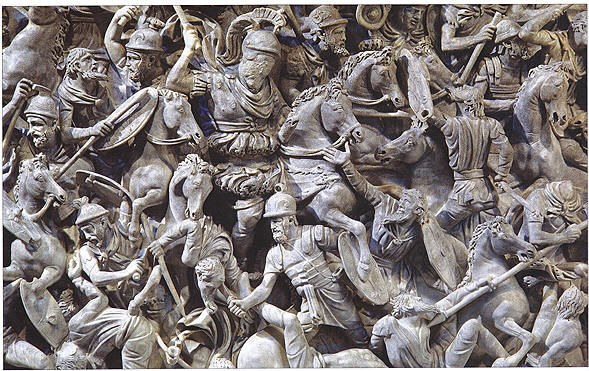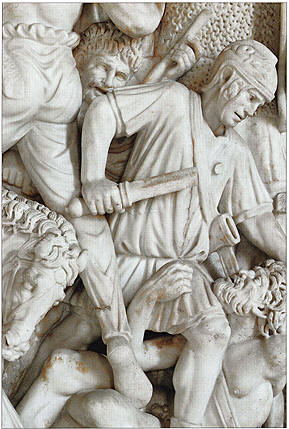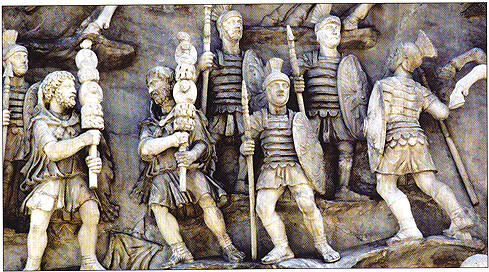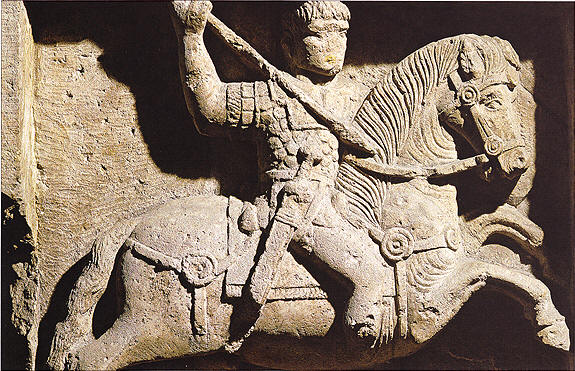Ancient Roman Weapons
The army of ancient Rome
(800Bc—AD476) was a formidable fighting force
—
well disciplined, organized and
supplied with an array of effective and
battle-proven weapons. The sword and spear were the
infantryman’s main weapons, and the spectacular
military successes of the Roman legions throughout
Europe and the Near East lay in the disciplined
battlefield application and relentless training in
the use of these weapons.
 The
Gladius The
Gladius
A short stabbing
weapon with a blade length of around 50—60cm
(19.6—23.6in), the gladius was the primary fighting
sword of the Roman soldier. Its origins are somewhat
uncertain, simply because very few examples have
been unearthed by archaeologists and the only
identifiable gladii have come not from Italy but
from Germany. This sword was described by the
ancient Romans as the “gladius hispaniensis”, in
recognition of a similar type of Celtic design
encountered by the Romans during their conquest of
Hispania (modern-day Spain) during the Second Punic
War (218—201BC). Before this, Roman soldiers would
have used swords of Greek origin.
The hilt, or capulus,
of the gladius featured a rounded grip, moulded with
four finger ridges to allow a comfortable and firm
hold upon the sword. Pommels were bulbous and
normally of plain form. The scabbard was made of
wood, covered with leather and strengthened by a
rigid frame of brass or iron.
RIGHT:
Legionaries, carrying gladius swords, are depicted
during battle in a relief carving from the base of a
column found at Magonza, Italy.
Wearing the
Gladius
Although in later
centuries most swords would be worn traditionally on
the left side, the gladius was worn on the right
side. This allowed the wearer to draw with the right
hand and at the same time carry a heavy shield in
the left hand. This can be confirmed from the
depictions of Roman soldiers on tombstones, wall
paintings and friezes. The tombstone of Annaius
Daverzius, an auxiliary infantryman who served with
the Cohors III Delmatarum, a Roman garrison
stationed in Britain during the 1st century AD,
shows his sword attached on the right side of his
belt by four suspension rings. As an acknowledgement
of his status, a centurion was allowed to wear his
sword on the left.
The Gladius in
Battle
If used with enough force and
directed at the most vulnerable parts of the body,
particularly the stomach, the stab of a gladius
blade into the flesh of an opponent was nearly
always fatal.
Roman soldiers fought as a
single fighting unit within an organized and massed
formation. This fighting block comprised hundreds of
men standing shoulder
to shoulder. They had to keep this formation solid
and it was crucial, therefore, that all soldiers
fought with the gladius placed in their right hand.
Any left-handed recruit would have this hand
strapped behind his back during training, and it
would be kept tied until he learned to fight with
the right hand as well as he would have done with
the left. Wearing the gladius on the right also
meant that the drawing of the sword would not
interfere with soldiers on either side, and would
also not restrict the use of the Roman scutum (the
shield).

ABOVE:
A battle between Roman and Germanic
armies, depicted as a relief on a marble
sarcophagus,
C.
AD18O—190.
The Roman line would wait for the enemy to come
right up to it and then await the order to advance.
Upon receiving this order, all soldiers would take
one step forward and thrust their shields, or scuta,
into the bodies and faces of the enemy, causing them
to lose their balance and so render them temporarily
vulnerable. The shield was then quickly withdrawn
and the gladius thrust into the body of the
opponent. The Roman soldier was taught to deploy the
gladius horizontally, so piercing the enemy’s ribs
and penetrating to his vital organs.

ABOVE:
A
gladius and scabbard, which belonged to an officer
of Tiberius
(42Bc—AD37),
the
second Emperor of Rome.

ABOVE:
A
stone depiction of the Emperor Hostilianus in a
Roman battle scene, 251AD. He is carrying a gladius,
of which the blade is broken.
The Spatha
By the middle of the 1st century AD, the gladius had
been replaced by the spatha (spada
is the modern-day
Italian word for sword). It had a much longer blade
(60—80
cm123.6—3
1 .5in) and shorter
point. The sword was Celtic in origin and it is
probable that Gallic cavalry (from Gaul, in
modern-day France), in the employ of Rome,
introduced the sword to the Roman Army during the
time of Julius Caesar (100—44Bc) and Augustus
(63Bc—14). It was a slashing weapon and designed to
be used by both the Roman cavalry and infantry.

ABOVE:
Found in Spain, this is the only known actual
example of a spatha with an eagle-headed hilt. It
would have been used by a tribune in the early 4th
century
AD.
The Manufacture
of Swords
By the time of the Roman Republic (c.509—44BC),
the use of steel in the manufacture of swords was
well advanced and Roman swordsmiths smelted iron ore
and carbon in a bloomery furnace (the predecessor of
the blast furnace). The temperatures in these
furnaces could not achieve the high levels required
to fully melt the iron ore, so the swordsmith had to
work with pieces of slag (residue left after
smelting) or bloom (mass consisting mostly of iron),
which were then forged into the required blade
shape. These pieces or strips of cooling metal were
welded together for increased blade strength. During
this process the owner’s initials or full name were
sometimes engraved onto the blade.
The Pilum
Around 2m (6.5ft) in length, the main heavy spear or
javelin used by the Roman Army was the pilum. It
consisted of a socketed iron shank with a triangular
head. The pilum weighed in at around 3—4kg
(6.6—8.8lb); later versions produced during the
Empire (27BC—AD476) were lighter. The pilum would
have been thrown by charging legionaries and could
easily penetrate shield and armour from a range of
around 1 5m (49.2ft). A lighter, thrusting spear,
the hasta, was also used for close-combat
situations.
The narrow, spiked shape of the spearhead meant that
when it became stuck in the wood of an opponent’s
shield it was extremely difficult to dislodge, so
disrupting the opponent at a critical moment of
battle. He might have to relinquish his shield,
leaving himself extremely vulnerable to the oncoming
Roman infantry. Even if he was able to remove the
spear, he couldn’t throw it back at the Romans
because the soft iron of the spear shank meant that
it bent on impact and so became useless as a weapon.
In the aftermath of a Roman victory, used pila were
gathered from the battlefield and sent back to the
Roman Army blacksmiths for straightening. The Roman
military strategist Vegetius (c.
AD450) comments on
the effectiveness of the pilum:
As to the missile
weapons of the infantry, they were javelins
headed with a triangular sharp iron, eleven
inches or afoot long, and were called piles.
When once fixed in the shield it was impossible
to draw them out, and when thrown with force and
skill, they penetrated the cuirass without
difficulty... from De Re Militari (c.AD430)
Later, a further development of
the pilum was introduced: the spiculum. Vegetius
notes its power:
They had likewise
two other javelins, the largest of which was
composed of a stafffive feet and a half long and
a triangular head of iron nine inches long. This
was formerly called the pilum, but now it is
known by the name of spiculum. The soldiers were
particularly exercised in the use of this
weapon, because when thrown with force and skill
it often penetrated the shields of the foot and
the cuirasses of the horse... from
De Re Militari
(c.AD430)

ABOVE:
Roman soldiers carrying light spears (lancea) and
shields. Detail of a relief from the Antonine
Column, Rome, erected
c.AD180—196
in recognition of the Roman victory in battle over a
Germanic tribe.

ABOVE:
Dating from
AD70,
this inscribed Roman commemorative stone depicts a
horseman (Vonatorix) wielding a spear.
The Contos
A long, wooden
cavalry lance which was 4—5m (13.l—16.4ft) in
length, the contos derived its name from the Greek
word kontos, or “oar”, which probably gives
some indication as to the length of the lance. It
took two hands to wield, so the horseman had to grip
his mount by the knees. To be able to do this
effectively would have taken considerable strength
and training.

ABOVE:
Made in the Roman provincial style, this contos
lance head dates from the 2nd century
AD.
|